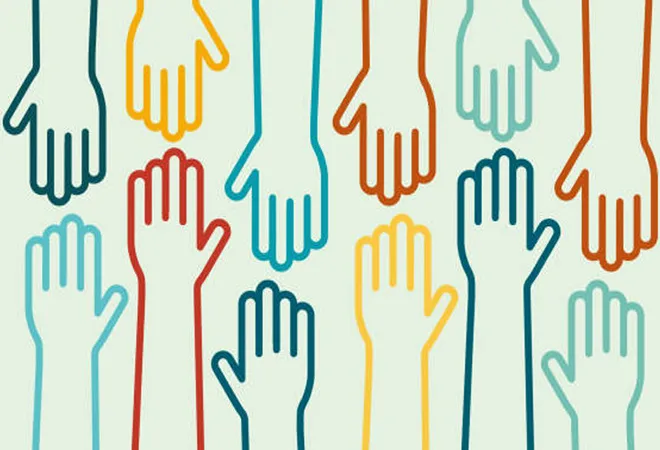
This piece is part of the essay series,
Amrit Kaal 1.0: Budget 2023
India has a
robust social welfare architecture that caters to the basic necessities of larger sections of vulnerable people across the country. One of the paramount challenges of the Indian state has been to facilitate a fine balance between ensuring fiscal prudence and consolidating social welfare. The
thrust of the Union budget this year has been on increased capital expenditure for achieving the dual targets of economic recovery and job creation, especially against the backdrop of the COVID-19 induced economic and livelihood crisis. The budget
has rationalised subsidies while keeping in mind the need to address the fiscal deficit. Hence, the budget has been a mixed bag in terms of its attempts to address social protection concerns, which are crucial for ensuring a life of basic dignity for socio-economically vulnerable groups.
The thrust of the Union budget this year has been on increased capital expenditure for achieving the dual targets of economic recovery and job creation, especially against the backdrop of the COVID-19 induced economic and livelihood crisis.
The keys areas in focus
The budget, in some important ways, attempts to address the welfare concerns of a cross-section of people, which
includes, ‘the youth, women, farmers, Other Backward Classes (OBCs), Scheduled Castes (SCs) and Scheduled Tribes (STs)’ with ‘a focus on infrastructure and investment that serves as a multiplier for growth and employment, policies to enable green or environmentally sustainable growth, the rationalisation of direct taxes, including a raft of concessions to the middle and salaried classes, and pensioners.’ Such a holistic developmental blueprint is aimed to be followed for
creating a ‘technology-driven and knowledge-based economy with strong public finances, and a robust financial sector’ with an eye on ‘India at 100’. One of the highlights
has been the NAMASTE (National Action Plan for Mechanised Sanitation Ecosystem) scheme through which the government intends to facilitate ‘scientific management of dry and wet waste.’ Though the existing Self Employment Scheme for Rehabilitation of Manual Scavengers (SRMS) has already made an important contribution in prohibiting manual scavenging in India, the problem has not been completely eradicated, as is suggested by
data from the National Safai Karamcharis under the Ministry of Social Justice and Empowerment. Hence, NAMASTE will be instrumental in identifying the people engaged in hazardous cleaning of sewers in the country and it
would provide “for capital subsidies to sewer cleaners on the purchase of sanitation machinery, training of workers with a stipend amount, and loan subsidies with capped interest rates on sanitation equipment.” It is very important for ensuring a healthy and dignified life for people engaged in the dehumanising work of manual scavenging.
There is an increase in post-matric and pre-matric Scholarship schemes for Scheduled Castes, which includes sizeable funds for the PM-AJAY scheme to ensure development of SC-dominated villages and districts.
Also, there is an
increase in post-matric and pre-matric Scholarship schemes for Scheduled Castes, which includes sizeable funds for the PM-AJAY scheme to ensure development of SC-dominated villages and districts. There has been fund allocation for the PM-YASASVI scheme, that includes scholarships for Other Backward Classes (OBC), De-notified Tribes (DNT) and the Extremely Backward Classes (EBC), which is extremely crucial for promoting educational opportunities to the vulnerable communities. Also, the allocation for the SEED scheme for economic empowerment of DNTs increased from last year’s INR 28 crore to INR 40.4 crore this year. An amount of INR 1,225.15 crore has also been allotted to the Department of Empowerment of Persons with Disabilities. The budget
has laid down that the Pradhan Mantri-PVTG Development Mission has been
allotted an expenditure outlay of INR 15,000 crores in the next three years in order to improve the socio-economic conditions of 75 identified vulnerable tribal groups across the country residing in 31,000 villages. One of the innovations of this budget has been the PM VIKAS or Pradhan Mantri Vishwakarma Kaushal Samman, which would give financial assistance to traditional artisans and craftspeople in the country that would help to improve the quality, production and consumption of their products. Also, the allocation for the government’s housing programme, the Pradhan Mantri Awas Yojana (PMAY) has been raised by 66 percent to over INR 79,000 crore that would help to continue promoting affordable housing. The Mahila Samman Savings Certificate, a small savings scheme with a tenure of two years and with an interest rate of 7.5 percent
has been allocated for women. The budget has also increased the upper deposit limit of the
Senior Citizens Savings Scheme from INR 15 lakh to INR 30 lakh.
Need for greater emphasis
However, there are certain areas of social welfare that need greater emphasis and attention. Notably, government spending towards both health and education has increased in terms of absolute numbers compared to last year but has slightly declined as a percentage of overall budget allocations. In education, the allocations have
increased from last year’s budget, where the budget estimate was INR 10,4277 and revised estimate was INR 99,881 crore, which has been increased to INR 112,890 crore this year. Expenditure on education as a percentage of overall budgetary allocation has slightly reduced to 2.5 percent this year, compared to 2.64 percent last year but has gotten the
highest allocation of funds ever in absolute numbers.
Efforts like a Digital Library, Pradhan Mantri Kaushal Vikas Yojana 4.0, increased funds for PM POSHAN and steps for revamping teachers’ training have been incorporated in the budget. However, the crucial Samagra Shiksha scheme
got only slight hike and there was no separate allocation for the National Digital University project announced last year.
One of the innovations of this budget has been the PM VIKAS or Pradhan Mantri Vishwakarma Kaushal Samman, which would give financial assistance to traditional artisans and craftspeople in the country that would help to improve the quality, production and consumption of their products.
The budget
estimate on healthcare was INR 86,200 crore in 2022-23, which was revised to INR 76,145 crore in comparison to the estimated outlay of INR 89,155 crore for this year. Healthcare constituted 2.2 percent of the total budgetary allocation last year, which has slightly dipped to 1.97 percent this year. However, the budget
has laid down a vision for ‘innovation in pharmaceuticals through centres of excellence, multidisciplinary courses for medical devices to ensure availability of skilled manpower and establishing nursing colleges.’ The National Digital Health Ecosystem, National Tele-Mental Health Programme, and the initiative to eliminate sickle cell anaemia
have been the major highlights in the domain of healthcare in this budget. Though the National Health Mission (NHM), Pradhan Mantri Swasthya Suraksha Yojana (PMSSY), National AIDS (Acquired Immunodeficiency Syndrome) and STD (Sexually Transmitted Diseases) control programme have
received an increase in allocation, more
focus is needed to improve primary healthcare. As per
studies on
this, India had 69,265 hospitals in 2019, which comes down to one hospital for every 20,350 Indians. Also, a sizeable section of people in the country
are not covered by medical insurance and have to rely on out-of-pocket expenditure for medical treatment. Hence, a further push towards strengthening primary healthcare infrastructure is needed.
A focussed long-term protection plan for internal migrant workers was missing in the budget.
In the agrarian sector, there has
been a fall in income from cultivation in absolute terms in the last few
years, with COVID-19 further aggravating the crisis. But, this year, the food and fertiliser subsidises have
faced budgetary cuts and there has
been limited fund allocation for dairy, animal husbandry, and fisheries. Though there has
been an increase in the Minimum Support Price (MSP) in the last few years, the cut in subsidies is likely to
impact the small farmers. Agrarian reforms are required to ensure long-term development. The food distribution scheme has
been modified, with the distribution of 5 kg of cereals under the Pradhan Mantri Garib Kalyan Anna Yojana (PMGKAY)—introduced during COVID-19—being stopped while the free food distribution under the Food Security Act would continue. Therefore, the overall food subsidy has been reduced from INR 2.87 lakh crore in 2022-23 to INR 1.97 lakh crore in 2023-24. The allocation for the Mahatma Gandhi National Rural Employment Guarantee ACT (MGNREGA), which has been
instrumental in addressing the challenge of employment crisis during the pandemic,
has been cut from INR 73,000 crore in 2022-23 to INR 60,000 crore in 2023-24. However, the government has
assured to allocate more funds for MGNREGA as per subsequent demands. The overall budget allocation for the Ministry of Minority Affairs
has been reduced by 38 percent, though the budget for post-matric scholarship for minorities has been increased this year. India
has 45 crore internal migrants, amongst which a sizeable section of migrant workers linger in acute vulnerability, which was clearly
revealed during the COVID-19 pandemic crisis. However, a focussed long-term protection plan for internal migrant workers was missing in the budget. Though the government
has taken initiatives, during the pandemic, to ensure better food, shelter and livelihood provisions for migrant workers, long-term structural social welfare initiatives to mitigate their vulnerability is an area that needs urgent redressal.
The budget has prioritised capital expenditure for addressing the needs of public infrastructure along with some focussed welfare initiatives in various crucial sectors. However, greater
emphasis on socio-economic upliftment of vulnerable sections would further strengthen India’s multi-dimensional welfare architecture that plays a pivotal role in improving the lives of larger sections of people.
The views expressed above belong to the author(s). ORF research and analyses now available on Telegram! Click here to access our curated content — blogs, longforms and interviews.



 This piece is part of the essay series,
This piece is part of the essay series,  PREV
PREV


